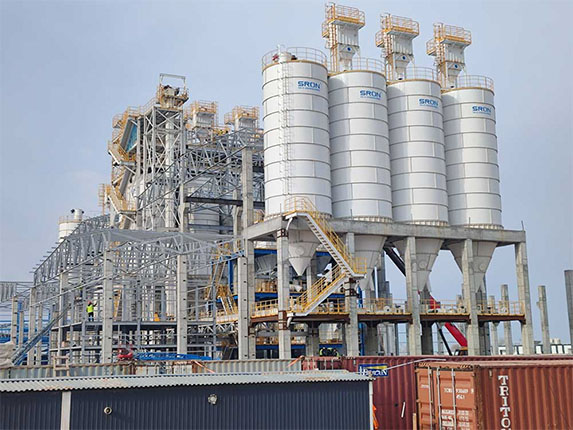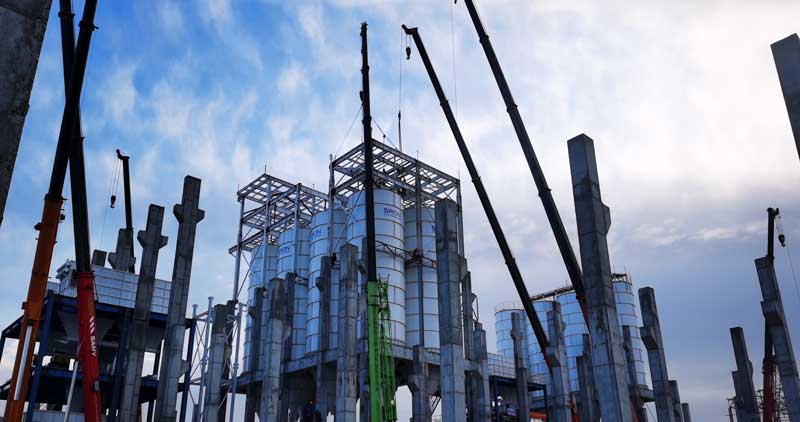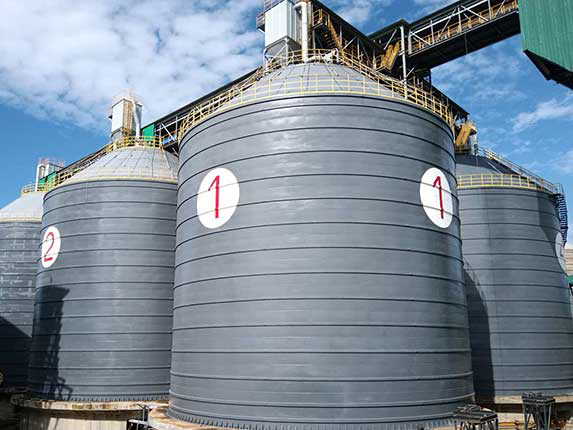Bolted Steel Silo
Storage capacity range: 50 tons to 2,000 tons (based on cement)
Diameter range: approximately 2.9 meters to 21 meters (customized according to storage capacity and project requirements)
Wall thickness: 4mm to 10mm (calculated based on pressure bearing and structural design)
Structural form: adopts a flat plate with edge flange folding design, with steel plates assembled into a whole through bolts
Applicable materials: cement, fly ash, gypsum powder, dry mortar, sand, mineral powder, lime powder, grain, etc.
Introduction
With the continuous improvement of industrialization levels and the increasing demand for efficient, flexible, and environmentally friendly construction methods in construction projects, traditional welded storage silos are gradually showing limitations such as inconvenient transportation, long construction periods, and high costs. In this context, bolted steel silos (also known as modular silos) have quickly gained widespread application in industries such as cement, chemical, power, and building materials due to their modular design, rapid assembly, high-strength structure, and environmentally friendly construction advantages, becoming an important solution for modern material storage systems.
Introduction to Bolted Steel Silo
A bolted steel silo is a bulk material storage device assembled from steel plates. Its components are prefabricated in a factory and transported to the site for overall assembly through bolt connections. This type of silo typically has a conical bottom, with the top of the silo body closed and a discharge cone at the bottom, suitable for storing and using various powdered or granular materials.
Application Industries and Scope
Due to its strong versatility and wide adaptability, bolted steel silos can be applied to almost all industries involving bulk material storage. Its main application industries and scenarios include:
Building materials industry: such as concrete mixing plants and cement production plants, for storing raw materials like cement, sand, and fly ash;
Power industry: centralized storage and secondary utilization of by-products such as fly ash and desulfurized gypsum from thermal power plants;
Metallurgy and mining: temporary or long-term storage of mineral powder and lime powder required in the steel smelting process;
Chemical industry: suitable for reserving and allocating granular or powdered chemical raw materials;
Grain storage: for storing grain materials such as corn, wheat, and soybeans, especially suitable for temporary or emergency storage;
Ports and docks: as transit warehouses or temporary storage points, facilitating rapid deployment and subsequent disassembly and transportation.
Especially in scenarios where storage capacity demand fluctuates greatly or project cycles are short, the flexibility advantage of bolted silos is particularly prominent.
Features and Advantages
Modular design, easy installation
All components are prefabricated in a standardized manner in the factory, requiring no large-scale welding operations on site. Assembly is completed solely through bolt connections, shortening the construction period by more than 50%, which facilitates quick commissioning and capital recovery for the owner.
Significant cost advantages
Transportation costs are reduced through modular transportation, and the short construction period lowers labor and equipment costs. Additionally, simple later maintenance reduces overall usage costs.
High strength, stable structure
The flange connection forms a longitudinal and transverse reinforcing rib structure, providing good wind and seismic resistance, suitable for various harsh natural conditions.
Good sealing performance
The sealing strip can withstand high temperatures of 200°C, with a reliable and effective sealing structure.
Flexible disassembly and reusable
Compared to traditional welded silos, the bolted structure can be disassembled, transported, and reassembled at any time, making it particularly suitable for temporary construction projects or multi-site usage needs.
Environmentally friendly and safe
The entire construction process involves no open flame operations or on-site welding, with minimal dust and noise pollution, aligning with modern green construction concepts.
Easy to expand and upgrade
Due to its flexible structure, the design can be adjusted in size or equipped with additional facilities at any time according to the type of material and capacity requirements, achieving personalized configuration.
Technology
Please feel free to give your inquiry in the form below.
We will reply you in 24 hours.











Production and Processing Flow of Bolted Steel Silos
Design confirmation: Conduct structural strength calculations and detailed design drawings based on customer needs and site conditions.
Raw material cutting: Use high-precision CNC plasma cutting or laser cutting technology to standardize the cutting of steel plates.
Edge processing: Form the edge flanges and punch holes according to the assembly drawings to ensure precision and assemblability.
Sandblasting and rust removal: Perform sandblasting and rust removal on the steel plate surfaces to meet the Sa2.5 standard.
Anti-corrosion coating: Apply primer and topcoat according to the usage environment to enhance anti-corrosion performance.
Quality inspection and numbered packaging: Each component is numbered and packaged according to the drawings to ensure efficient on-site assembly.
Construction Process of Bolted Steel Silos
The silo body and top of the bolted steel silo are formed into segmented parts in the processing plant. After segmentation, the connection nodes mainly include vertical splicing nodes and horizontal splicing nodes. Each segmented steel silo is assembled with bolts of equal strength around it. The engineering team of SRON will comprehensively consider the wind speed, seismic activity, and temperature at the silo installation site to ensure that the thickness of the silo body plates, bolt strength, and support leg strength meet safety requirements.
Specific construction process:
Foundation construction: Carry out foundation treatment and installation of concrete foundations or bolt cage embedded parts to ensure the stability of the silo body.
Silo body assembly: Start from the bottom of the silo body and assemble the steel plates layer by layer, using mechanical lifting and manual cooperation to complete the docking.
Top construction: Install the silo top plate, manhole, inspection port, safety guardrail, and other accessories.
Auxiliary system connection: Connect the feeding pipe, discharge pipe, dust collector, level gauge, vibration arch breaker, and other auxiliary devices.
Commissioning and acceptance: Comprehensively check the bolt fastening, structural sealing, and operation status of supporting equipment, and complete the overall acceptance and delivery.
The entire installation process usually takes only 2 to 7 days (depending on the size of the silo and the capability of the construction team), greatly improving project efficiency.